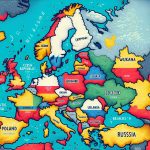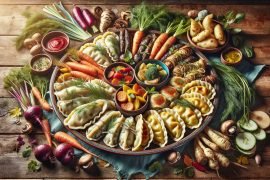
Christmas in Poland is full of tradition and culture, mixing serious religious ceremonies with warm family gatherings. The centerpiece of the Polish Christmas is the Wigilia, the Christmas Eve feast. It’s a special meal that follows a no-meat rule and includes unique customs like sharing a piece of Christmas wafer called opłatek.
This overview of Polish Christmas customs, from the religious practices to the special foods, is just a start. There’s a lot more to discover about how Poles celebrate this holiday season. To really get it, you need to dive deeper into these traditions.
The Significance of Wigilia
Wigilia is a key part of Christmas Eve in Poland, bringing families together for a special dinner that’s rich in tradition and meaning. This event is more than just a meal; it’s a celebration that connects people to their cultural and religious roots. In Poland, Christmas Eve is a time for family, reflection, and preparing for Christmas Day. Wigilia embodies this spirit through its unique customs, such as fasting during the day and then enjoying a feast that starts when the first star appears in the sky. This practice not only honors Polish heritage but also creates a sense of community and continuity.
The dinner on Wigilia is carefully planned and includes foods that are significant to Polish culture. For example, the tradition of sharing opłatek, a thin wafer, symbolizes forgiveness and unity among family members. The meal itself usually features dishes that are meatless, respecting the day’s fasting by focusing on fish, grains, and vegetables. This approach to the meal showcases the importance of tradition and the value of spending time with loved ones.
What sets Wigilia apart from other Christmas celebrations around the world is its emphasis on tradition and the way it brings people together. The sighting of the first star, for instance, is not only a beautiful moment but also a reminder of the connection between the spiritual and the earthly. This blend of solemnity and anticipation, along with the joy of gathering with family, makes Wigilia a unique and meaningful celebration.
In a more conversational tone, think of Wigilia as the heart of Christmas in Poland. It’s a time when families come together, share stories, and enjoy a meal that’s been prepared with love and attention to detail. Each dish has its own story, and every custom is a nod to the past while looking forward to the future. It’s a beautiful blend of faith, family, and heritage that captures the true spirit of the holiday season.
Sharing the Opłatek Tradition
The sharing of opłatek is a heartwarming Polish tradition that truly captures the essence of Christmas Eve, known as Wigilia. This custom involves family members exchanging a thin, unleavened wafer, symbolizing peace and goodwill. It’s interesting to note that this practice shares similarities with ancient rituals of bread-sharing, which also aimed to strengthen community bonds.
In Poland, the opłatek tradition is much more than just a ritual; it’s a way to bring family members closer together, encouraging forgiveness and unity. This is particularly significant during Christmas Eve, a time when harmony and love are in the air. The act of breaking the opłatek and sharing it, while wishing each other well, is not just about following a custom. It’s a deeply meaningful gesture that reinforces the ties between family members, reminding everyone of the importance of togetherness and the true spirit of Christmas.
Unlike other traditions that might solely focus on the religious aspect, the sharing of opłatek beautifully blends Christian symbolism with ancient Slavic customs. This mixture of influences makes the tradition uniquely Polish, showcasing how cultural practices can evolve over time while still maintaining their core significance.
Imagine this scene: a family gathered around the table on Christmas Eve, passing around the opłatek, each person taking a piece and offering heartfelt wishes to the others. This simple yet profound act symbolizes so much more than just the words exchanged; it’s about reaffirming the bonds that hold the family together, offering a moment of reflection and connection in our often too busy lives.
In a world where we’re constantly looking for ways to connect more meaningfully with our loved ones, the opłatek tradition serves as a beautiful example of how simplicity can lead to deep, emotional connections. It reminds us that sometimes, it’s the small gestures that count the most, especially during the holiday season. So, whether you’re Polish or not, embracing the spirit of opłatek can add a layer of warmth and closeness to your Christmas celebrations, making them even more memorable.
Midnight Mass and Religious Observances
In Poland, the Midnight Mass, or Pasterka, is a key part of Christmas celebrations. It brings families and communities together in a meaningful way, showing the strong Catholic faith of the nation. Unlike the commercial side of Christmas in some cultures, Pasterka focuses on spiritual reflection and bringing people together. This practice is not just a ritual; it strengthens the bond within the community and reinforces Polish cultural identity. It’s interesting to see how Midnight Mass is celebrated worldwide, but in Poland, it’s deeply tied to the country’s history and culture.
Let’s break it down further. During Pasterka, churches across Poland are filled with people who gather to celebrate the birth of Christ. This isn’t just about attending a service; it’s a communal experience that reflects a shared heritage and belief system. It’s a vivid example of how traditions can bring people closer, not just to their faith but also to each other.
Comparing this tradition to how other countries celebrate Christmas can be fascinating. While Midnight Mass is a common practice in many Christian communities, Poland’s version stands out because of its historical and cultural significance. It’s a reminder of how traditions can shape and reflect the identity of a nation.
In a world where Christmas can often feel commercialized, Pasterka offers a moment of pause and reflection. It’s a time for people to come together, not for the gifts or the food, but for a shared experience that goes back centuries. This tradition isn’t just about religion; it’s about community, heritage, and the values that hold a society together.
Traditional Polish Christmas Cuisine
In Poland, Christmas is much more than a religious event; it’s a time when cultural and culinary traditions come alive, especially during the Christmas Eve feast known as Wigilia. This meal is a direct reflection of Poland’s Catholic beliefs, with a focus on fish, grains, and vegetables instead of meat, setting it apart from other Christian celebrations where meat dishes often take center stage. This difference highlights the unique Polish approach to Christmas, where food plays a critical role in the celebration.
One of the most interesting aspects of Wigilia is the tradition of preparing twelve dishes, which represent the twelve apostles. This practice mixes religious symbolism with culinary tradition, showing how deeply food and faith are intertwined in Polish culture. Unlike in some cultures where the emphasis might be on one main dish, the variety in the Polish Christmas Eve meal underscores the importance of community and sharing.
Fish, especially carp, is a staple of the Wigilia meal, along with pierogi, beetroot soup (barszcz), and various kinds of cakes and pastries. Each dish is prepared with care, following recipes that have been passed down through generations. This connection to the past is a key part of the celebration, linking today’s festivities with the traditions of ancestors.
The emphasis on meatless dishes during Wigilia also speaks to the Polish value of sacrifice and reflection during the advent season, setting a tone of anticipation and spiritual readiness for Christmas Day. This approach to holiday cuisine offers a unique perspective on how food can reflect broader cultural and religious values.
In a more conversational tone, it’s like Poland has its own special way of celebrating Christmas, with food that brings people together and tells a story of faith, history, and community. The Wigilia meal is not just about eating; it’s a meaningful part of the holiday that connects everyone to the deeper significance of Christmas in Poland. Whether it’s sharing a piece of opłatek (Christmas wafer) or enjoying a spoonful of barszcz, each tradition and dish adds to the rich tapestry of Polish Christmas, making it a unique and deeply personal experience.
Decorations and Christmas Markets
In Poland, Christmas isn’t just about the dinner; it’s also about the dazzling decorations and lively Christmas markets that add to the holiday’s charm. The decoration of cities and homes combines Christian symbols with ancient traditions, showing a rich history of blending different beliefs. You’ll see streets lit up with lights and nativity scenes, and homes often feature szopki (handmade cribs) and choinki (Christmas trees), bringing a warm, festive atmosphere.
Polish Christmas markets, particularly famous in Krakow and Warsaw, are more than just shopping spots. They emphasize local craftsmanship, traditional food, and folklore, making them unique compared to those in Western Europe. These markets are not just about buying and selling; they’re community hubs where people come together to celebrate Christmas, creating a strong sense of togetherness and joy.
For example, if you visit Krakow during the holiday season, you’ll experience the magical Christmas market in the Main Square, surrounded by Gothic and Renaissance architecture. Here, you can find everything from hand-painted ornaments to smoked cheese and mulled wine, showcasing the best of Polish culture and cuisine. It’s a place where the holiday spirit truly comes to life, offering a unique experience that reflects the local customs and traditions.
Conclusion
Christmas in Poland is a big deal, deeply rooted in both culture and religion. It’s full of traditions like Wigilia, which is the Christmas Eve feast, sharing Opłatek, which is a Christmas wafer, attending Midnight Mass, enjoying specific foods, and putting up festive decorations.
These traditions are not just about celebrating; they bring people together, strengthen cultural ties, and keep the religious spirit of the holiday alive. In simple terms, the way Poles celebrate Christmas is a great example of how traditions can keep a community close, pass on beliefs, and keep everyone connected.






Comments are closed.